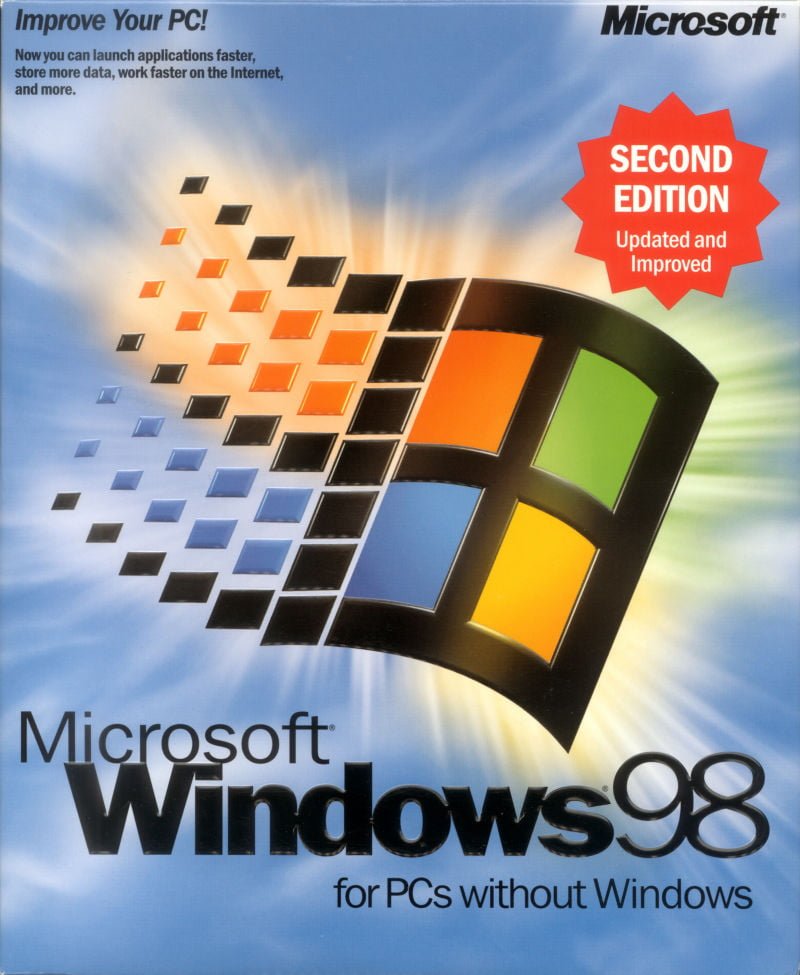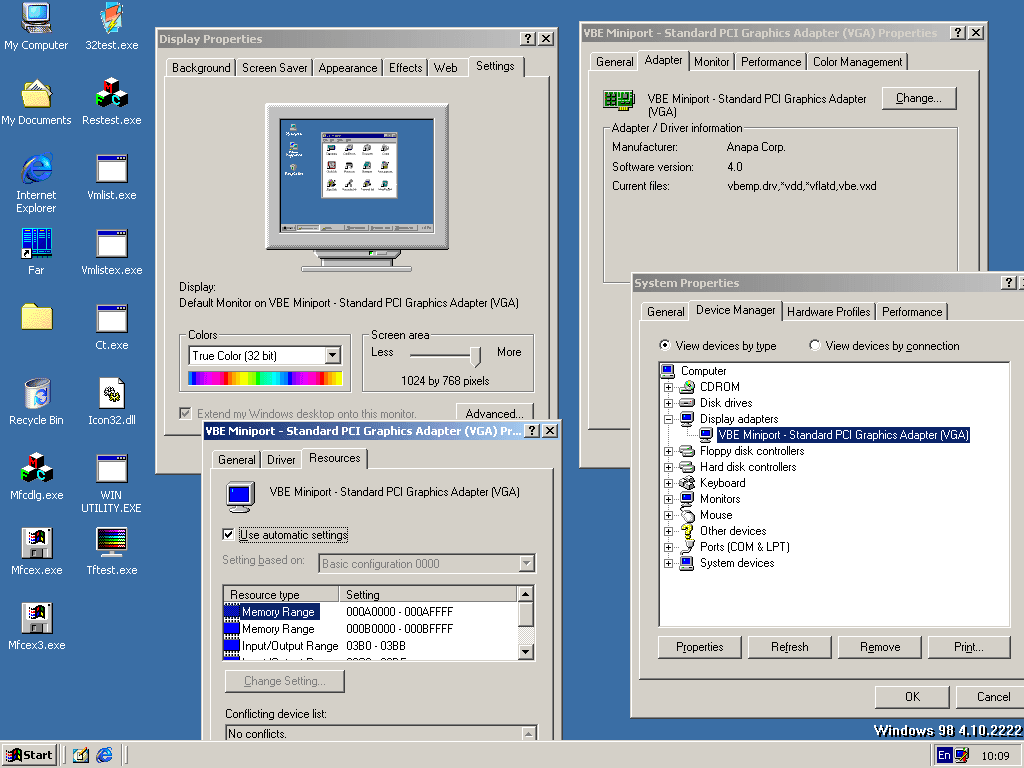Windows 98 was a GUI based operating system that was released by Microsoft in 1998. It was released as a part of the 9x series of the windows operating system which included its predecessor, Windows 95. Windows 98 was released in both 32 and 16-bit versions just like the older windows 95 and it was based on the Disk Operating System (DOS) which was a Command-Line operating system developed by Microsoft. Windows 98 was released on the 15th of May in the year 1998 and was put on sale worldwide on the 25th of June in the same year.
After Windows 98, came the Windows 98 SE. Here, SE stands for Second edition and was released on the 5th of May in the year 1999. Both Windows 98, as well as the Windows 98 SE operating systems, were supported by Microsoft till the 30th of June 2002. Buyers could, however, get extended support till the 11th of July 2006. You can download Windows 98 ISO from our website.

Features of Windows 98 ISO

Taskbar and Start Menu
The taskbar, one of Windows 95’s smarter innovations, is even better in Internet Explorer 4.0 and Win98. Microsoft has hewn the new improved version closely to the “if it’s not broken, don’t fix it” school of thought. There’s been no mind-bending, radical overhaul, but rather the addition of significant and useful enhancements.
People found the new Web-savvy features helpful (though new users thought that they might complicate matters). With Windows 98, the Favorites folder was found on the Start menu. Under the Find folder, a “Find… On the Internet” choice took you to Microsoft’s search site.
The Start menu additions were notable, but the taskbar itself was where the action is. Microsoft finally heeded the cries of Windows 95 users who craved the ability to drag-and-drop document, application and folder shortcuts directly onto the taskbar, the way they could with the Office97 Software.
Web View
Windows 98’s Web View mainly did three things: It performed single-click navigation; it provided a way to view and customize the appearance of folders; and it added a fifth icon view to the original four views which were large icons, small icons, list, as well as details.
Web View shouldn’t be confused with Win98’s many hooks into the Internet. With Windows 98, you could get to the Web anytime from anywhere in Win98, even with Web View turned off. Likewise, you could enjoy Web View without an Internet connection. As such, Web View was a misnomer. A better name would be Browser View because it really enabled you to navigate and view the files on your computer with a browser-like interface.
Multimedia Support
MMX (Multimedia Extensions) was a set of 57 new instructions that Intel had added to certain x 86 processors to speed multimedia tasks. Each instruction greatly sped up processing by abbreviating the multiple instructions previous processors require to accomplish a given task. MMX-enhanced processors included Intel’s P55C Pentium and Pentium II, AMD’s K6 and Cyrix’s 6x86MX. Windows 98 was the first operating system to support MMX, which meant improved performance for image processing, video, audio, video conferencing and similar functions.

Scripting and Automation
The Windows Scripting Host (WSH) was the successor to the venerable DOS batch file format. WSH was a standard feature of all versions of the Windows 98 operating system. WSH incorporated both the JavaScript and VBScript engines that first appeared in Microsoft’s Internet Explorer and Internet Information Server (IIS), allowing batch files to be written in either language. WSH supported all the standard features of both languages, including subroutines and functions, variables and arrays, true if/else statements, other flow-control statements that allow sophisticated looping and much more.
Microsoft even provides two complete versions of Windows Scripting Host. One (CSCRIPT.EXE) is a command-line utility that can run in a DOS box under either Memphis or Windows NT 5.0. The other (WSCRIPT.EXE) is a standard 32-bit Windows application. Either can be chosen as your default scripting host (the one that runs automatically when a user double-clicks or runs a script file). Both versions support all JavaScript, VBScript and WSH features.
Performance
Microsoft figured out a good way to make Windows 98 faster. The Disk Defragmenter Optimization Wizard tracked the programs you ran most often, then clustered those programs on the fastest part of your hard disk. To use it, close down all applications and launch the wizard. It lets you choose programs you run frequently, launches them and notes which files are accessed from the hard disk for each.
One of the key pieces to Win98’s performance puzzle was WinAlign, a utility that aligns the contents of program files so they load faster-20% faster (or more). With speedier access to your applications and the data they use, you were able to trim unproductive wait times.
Load times are slower with unaligned code because Win98 must copy it from the disk-cache page to a brand new memory page aligned on a 4KB boundary. Aligned programs would start faster because Win98 runs the code directly from the disk-cache pages where they were loaded.
File System
With Windows 98, Microsoft introduced the new and improved FAT32 (File Allocation Utility) file system. FAT32 frees up hard-disk space by allocating the space much more efficiently than previous versions of FAT did. With FAT32, you can get an average of 28 percent more disk space without buying any new hardware. Launch software programs faster when you combine FAT32 with Microsoft Windows 98 Disk Defragmenter. With FAT32 you can work with a very large hard disk which can be over two terabytes it’s easier with FAT32 because you can represent the disk with a single drive letter, rather than splitting it in two.
Minimum System Requirements for Windows 98 ISO
Here are the minimum requirements your computer hardware must meet in order to run Windows 98:
- Computer/processor: 486DX/66 MHz or higher processor.
- Memory: 16 megabytes (MB) of memory; more memory improves performance.
- Hard disk: Typical installation requires approximately 195 MB of free hard-disk space, but may range between 120 MB to 295 MB, depending on your system configuration and the options you choose to install.
- Drive: CD-ROM or DVD-ROM drive (3.5″ high-density disks available for an additional charge).
- Display: VGA or higher-resolution monitor.
- Peripheral/miscellaneous: Microsoft Mouse or compatible pointing device.
How to get Windows 98 ISO Download for Free
Now that you know about the features of Windows 98 and would like to try it for yourself, you can download Windows 98 ISO from our website.
To download and install Windows 98 ISO for free, follow these steps:-
- First, download the Windows 98 ISO file.
- You can now use a pen drive or burn the ISO file to a disk using software like Power ISO.
- Boot into the USB drive or the CD/DVD and follow the installation instructions to install Windows 98 ISO on your computer.
Alternatively, you can also install the Windows 98 ISO on a Virtual Machine using Virtualbox or similar software. Just make sure that your computer supports virtualization and boot up the virtual machine with the Windows 98 ISO as the virtual disk and follow the installation instructions to install Windows 98 ISO on a virtual machine.





OH windows 98 I think I want to try it right now because I have never tried it before
me too
yeah you should get the experience of 98′. but before you must have the compatible hardware
I hope this works!
Young people, you missed all the fun of Dos and Windows 98, also Windows ME 😀
windows ME was sucktastic
Mistake-Edition
i hope it works
Im on 13 and im using vbox to emulate it 😀
I hope its work if its not then I will go to utube youtube
where is the product key
i need produc key
WIN 98 SE: C3MH2-8DP7G-JGQ7F-PM73H-YB3PT
C3MH2-8DP7G-JGQ7F-PM73H-YB3PT
It work ty
Try installing it from CD and get the message: Windows 98 setup files were not found What am i doing wrong?
i hope this product key works
Enjoyed a lot with win8. Super fast OS at that time.
Works great. Use the iso as virtual cd rom to boot from (can set in setup in virtualbox)